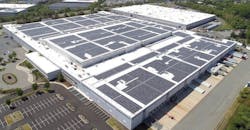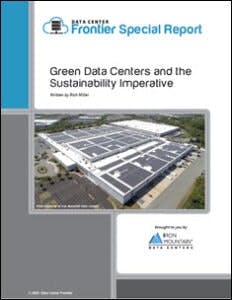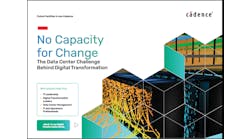The Sustainability Imperative: Green Data Centers and Our Cloudy Future
The urgent need for climate action is writ large in the headlines of 2020. Devastating wildfires have ravaged California, Oregon and Colorado, while a historic series of powerful hurricanes slammed the Gulf Coast. These disasters have been a tipping point in public awareness, driving home the fact that a changed climate is not a future threat, but a current reality. This launches the Data Center Frontier Special Report series exploring green data centers and the sustainability push in the colocation industry.
Get the full report.
The data center industry has been a force for positive change on climate action over the past decade, with cloud computing platforms pioneering advances in sustainable operations and corporate adoption of renewable energy. This impact will be amplified in coming years as more businesses abandon carbon-heavy on-premises data centers and migrate to greener infrastructure operated by cloud platforms and colocation facilities.
In this special report, we will examine the role of green data centers as a catalyst for action on climate change, specific strategies that are reducing carbon impact, and the best ways to embrace the sustainability imperative going forward.
The massive energy footprint of cloud computing enables the data center industry to drive a global shift to renewably-powered business. This opportunity is magnified by a digital transformation that is shifting much of our lives to online platforms —a trend that has been dramatically accelerated by the COVID-19 pandemic and the need for remote work, contactless commerce and automation as tools to reduce viral exposure.
The migration to cloud platforms has slashed the carbon footprint of many IT departments. But it is time for the data center users and operators to raise their game, not just because sustainability is good policy, but because it is good business.
Customers and stakeholders are demanding accountability on climate impact, pushing sustainability near the top of the agenda in selecting sites and providers. The data center industry is in a unique position to accelerate the adoption of sustainable practices and reduce the damage to our changing climate.
Wind power and other sustainale energy sources are growing in strategic importance for data centers. (Photo by RawFilm on Unsplash
The focus on sustainability has intensified in recent years with large cloud platforms making aggressive commitments to climate action. In January Microsoft said it will become “carbon negative” by 2030, and implement new procurement procedures in July 2021 to incentivize suppliers to reduce their carbon emissions.
Meanwhile, Amazon Web Services has committed to use 100% renewable energy by 2025, ahead of the 2030 timeline for Amazon’s broader operations. That goal cannot be met without a major acceleration of renewable energy purchases to support Amazon Web Services.
These announcements have huge implications for the data center industry. As the largest cloud builders deepen their commitments to green energy, the entire data center supply chain must embrace sustainability in new ways. Hyperscale customers have driven much of the growth for data center providers with a global footprint, leasing hundreds of megawatts of space on an annual basis.
The hyperscale players are leaders in the drive for greener data centers, but they are not alone. Eighty six percent of the companies in the S&P 500 Index published a sustainability report in 2018, up from only 20% in 2011, notes the Governance and Accountability Institute.
WEBINAR: Register Today for the “Green Data Centers and the Sustainability Imperative Webinar,” to be held Wednesday, Feb. 10.
A recent survey from 451 Research found that almost a third of multi-tenant data center (MTDC) representatives said all their customers want contractually binding commitments to efficiency and sustainability, while another 44% said it is true for most of their customers.
“Major enterprises and IT service providers (particularly larger cloud firms) typically have stringent infrastructure efficiency demands because it filters through to their own respective sustainability reports,” 451 said. “Simply put: they cannot afford to use MTDC providers that do not prioritize high efficiency and sustainability standards.”
The Data Center Industry’s Sustainability Journey
There have been two major phases of green innovation in the data center industry.
In the first phase, from roughly 2007-2014, the largest data center operators dramatically improved the efficiency of their IT equipment and data center facilities. For companies like Google, Facebook and Amazon Web Services, this meant innovating in every aspect of operations, from the chips powering servers to the power infrastructure and cooling systems. This relentless focus on efficiency yielded huge savings in electricity, slashing the carbon impact of these Internet businesses. The efficiency efforts brought a greener bottom line as well as greener data centers.
By imposing sustainable practices upon the supply chain for digital business, the data center industry will be an even more potent force for climate action.
In the second phase of the industry’s sustainability journey, large data center operators have focused on procuring renewable energy to power their operations instead of electricity sources based on coal. Google’s use of power purchase agreements (PPAs) for renewable energy has been adopted by other cloud providers and data center REITs. As a result, leading technology companies are now the largest users of renewable energy, and the most active buyers in energy markets for solar and wind power generation.
Renewable purchasing was initially concentrated at hyperscale players, but multi-tenant data center service providers have recently begun working with nonprofits to develop best practices for allowing colocation customers to claim pass-through credits for the renewable energy arranged by their data center provider.
This has laid the groundwork for the next phase of the data center industry’s green journey—a wholesale shift of the entire supply chain, as the largest players require their suppliers to document their procurement processes and vet them through a sustainability lens.
By imposing sustainable practices upon the supply chain for digital business, the data center industry will be an even more potent force for climate action. To realize its greatest impact, the industry will need to win the confidence of enterprise customers that continue to house IT operations in on-premises data centers, including many older facilities with an outsized carbon footprint.
Data centers have dramatically improved their energy efficiency, resulting in a small increase in industry electricity use during a period of explosive growth for cloud computing and online services.
As enterprise IT users redouble their focus on sustainability, they will be seeking data center service providers who can serve as partners as they slash carbon impact, deliver on corporate climate commitments, and build a greener planet.
Follow this report series over the coming weeks as explore topics like water conservation and management, eliminating diesel generators, heat recycling and more, as well as share a conversation with leading voices on the future of sustainable data centers.
Download the full report, Green Data Centers and The Sustainability Imperative, courtesy of Iron Mountain, to explore how climate change and a greening of data centers is changing the industry.







